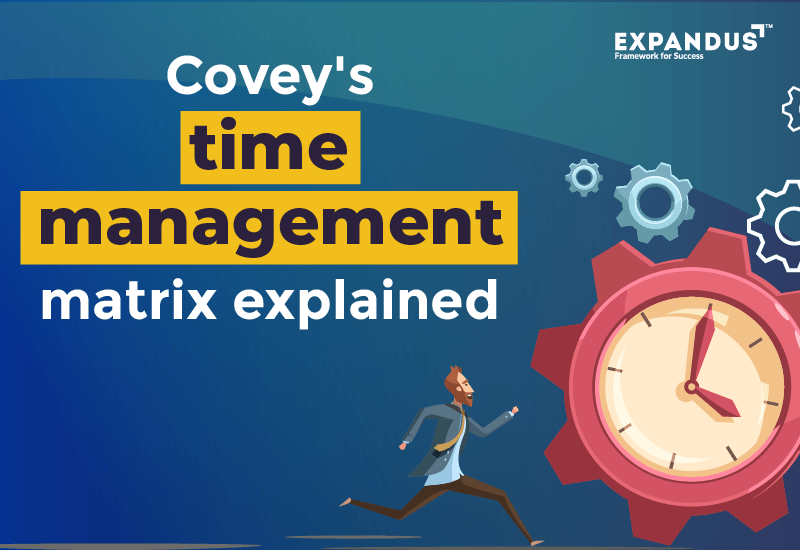Covey’s Time Management Matrix: An In-depth Guide
Managing your time is super important for both your personal and professional success. With smartphones around, there are tons of distractions. Figuring out how to manage your time effectively has become even trickier. But don’t worry; there are lots of methods out there. One really good one is the Covey Time Management Matrix by Stephen Covey. It’s a game-changer!
The Covey’s Time Management Matrix is not just a concept. It’s a practical tool that helps you decide where to invest your time and energy. This tool helps us focus on the important stuff in our to-do list, making our businesses more successful in the long run. Think about making organized lists, getting more work done, and handling life’s important tasks. Let’s check it out!
Understanding Covey’s Time Management Matrix (Covey’s Four Quadrants)
Let’s dive into the Covey Time Management Matrix, a cool tool by Stephen R. Covey. Covey thought all tasks fit into two categories: urgency and importance. Urgent tasks need quick attention, and important ones help us reach our goals. Now, imagine a Stephen Covey Matrix with four parts, like a big square split into four smaller squares. Each square is a quadrant, and they show different mixes of urgent and important tasks. It’s like a guide to organize our tasks better!
Quadrant I: Urgent and Important Tasks
Quadrant I is like the superhero zone. Tasks here are both urgent and important, needing our immediate attention. These are the tasks that demand quick action because they could lead to big problems if not addressed promptly. It’s the firefighting area, where we deal with things that can’t wait.
Examples of Tasks in Quadrant I:
- Deadline-driven projects: Tasks with close deadlines that can’t be postponed.
- Emergencies: Dealing with unexpected issues that require immediate attention.
- Critical meetings: Situations where decisions need to be made urgently.
Strategies for Managing Quadrant I Tasks:
- Prioritize: Identify tasks based on their urgency and importance. Tackle the ones that need immediate attention.
- Plan Ahead: Try to foresee potential Quadrant I tasks and plan accordingly to prevent last-minute rushes.
- Stay Proactive: Addressing tasks in this quadrant promptly helps prevent them from becoming major crises.
Quadrant I is like the superhero zone, where we save the day by handling urgent and important tasks with speed and precision. Prioritizing and planning are our secret weapons to navigate this quadrant successfully.
Quadrant II: Not Urgent but Important Tasks
Quadrant II is like the strategist’s corner. Here, tasks are important but not urgent. These are the tasks that contribute to our long-term success and personal growth. Quadrant II is the sweet spot for planning, reflecting, and investing time in activities that align with our goals. It’s where we plant seeds for a fruitful future.
Examples of Tasks in Quadrant II:
- Long-term goal setting: Planning for future achievements and personal development.
- Relationship building: Investing time in meaningful connections with family, friends, and colleagues.
- Proactive health management: Activities like regular exercise and healthy eating for long-term well-being.
Strategies for Prioritizing Quadrant II Tasks:
- Scheduled Planning: Set aside dedicated time for planning and goal-setting regularly.
- Preventive Actions: Address potential issues before they become urgent tasks in Quadrant I.
- Learn to Say No: Avoid getting overwhelmed by saying no to less important tasks that could distract from Quadrant II priorities.
Quadrant II is the strategist’s corner, where we focus on tasks that shape our future. It’s about being proactive, setting goals, and investing time in activities that contribute to our long-term success. By scheduling, preventing, and staying focused on our priorities, we make the most of Quadrant II.
In Quadrant II, you’re like the boss of your success story, building a future full of cool accomplishments and happiness. Just focus on what really matters, help yourself grow, and keep a chill and balanced life. Say no to things that distract you and use the superpower of planning your time. This way, you unleash all the awesome possibilities of Quadrant II, making sure your tomorrow is even better and more successful!
Quadrant III: Urgent but Not Important Tasks
Quadrant III is like the tricky zone full of tasks that seem urgent, but they’re not really that important in the big picture. These tasks might grab our attention because they scream for it, but working on them doesn’t get us closer to our main goals. It’s essential to be aware of these tasks to avoid getting sidetracked.
Examples of Tasks in Quadrant III:
- Unnecessary Meetings: Meetings that pop up and demand our time but don’t contribute much to our major goals.
- Some Phone Calls: Calls that aren’t vital and might take up time better spent elsewhere.
- Unplanned Interruptions: Unexpected distractions that might feel urgent but don’t align with our important tasks.
Recognizing and Minimizing Quadrant III Activities:
- Prioritize Your Goals: Focus on what truly matters to your big goals before diving into tasks that only seem urgent.
- Learn to Say No: Politely decline tasks or activities that, while urgent, don’t align with your important goals.
- Set Boundaries: Establish clear boundaries to minimize unnecessary interruptions and stay focused on your priorities.
- Evaluate Importance: Before jumping into a task, ask yourself if it genuinely contributes to your significant goals. If not, reconsider.
Understanding and managing Quadrant III tasks is like steering clear of tempting detours on your journey. By recognizing and minimizing these activities, you free up time and energy for what truly matters in Quadrants I and II—your key goals and long-term success.
Quadrant IV: Not Urgent and Not Important Tasks
Quadrant IV is like the chill zone where tasks neither scream for attention nor play a big role in our long-term goals. These are the activities that won’t make a big impact on our success. Think of them as the “avoid if possible” tasks, like scrolling endlessly on social media or binge-watching without purpose.
Examples of Tasks in Quadrant IV:
- Mindlessly scrolling through social media
- Watching random videos for hours
- Engaging in activities that don’t contribute to personal or professional growth
Strategies for Avoiding Quadrant IV Time Wasters:
- Set Clear Priorities: Identify what truly matters and focus on tasks that align with your goals.
- Create a Schedule: Plan your day with purpose, allocating time for important tasks and minimizing activities that waste your time.
- Practice Saying “No”: Politely decline tasks that don’t contribute to your priorities or goals.
- Use Technology Wisely: Limit your time on distracting apps and set boundaries for digital activities.
- Evaluate Regularly: Reflect on your activities to ensure they align with your priorities and adjust as needed.
Quadrant IV is where we need to be cautious not to get lost in time-wasting activities. By recognizing and avoiding these tasks, we free up more time for things that truly matter and contribute to our personal and professional growth.
Applying Covey’s Time Management Matrix
Start by checking how you manage time. Look at your daily tasks using the Covey Time Management Matrix. Put tasks into urgent or important groups. It’s like making a picture to show what’s really important. Then, make a plan for managing your time. Focus on Quadrant II, which helps for long-term success. Match daily activities with your goals, choosing tasks that really matter. Keep checking and changing your plan to fit your priorities. This way, you use time well and grow in your personal and work life. The Covey Matrix is like a guide, making life organized and purposeful, changing how you handle time for the best results.
Easy Steps to Apply Covey’s Time Management System Matrix:
- List Your Tasks: Make a list of your daily tasks, big or small.
- Identify Urgency and Importance: Use the Matrix to decide if each task is urgent, important, both, or neither.
- Categorize Tasks: Put each task in the right Quadrant (I, II, III, or IV) based on its urgency and importance.
- Prioritize Quadrant II: Focus more on Quadrant II tasks for long-term success. These are important but not urgent.
- Align with Goals: Match your daily activities with your goals. Emphasize tasks that help you reach where you want to go.
- Regularly Review and Adjust: Check your plan often. If priorities change, adjust your tasks accordingly.
- Stay Flexible: Be open to changes. Sometimes urgent things come up, and that’s okay. Adapt your plan when needed.
By following these easy steps, you’ll apply Covey’s Time Management Matrix effectively, making your days more organized, purposeful, and focused on what truly matters.
Benefits of Using Covey’s Matrix
When it comes to doing well in personal and work life, handling time is super important. That’s where Covey’s Matrix comes in—a fantastic tool made by Stephen R. Covey. This tool sorts tasks by how urgent and important they are, giving us a smart way to decide what to do first. It’s like a secret plan to organize our day and get things done in a better way. So, let’s dive into the world of Covey’s Matrix and find out how it can make our lives more organized and successful!
- Increased Productivity and Efficiency
Want to do more things and do them faster? That’s where Covey’s Matrix comes in handy. It helps you pick the most important things to do first. It’s like having a special trick to get your work done quicker and better. So, with Covey’s Matrix, you become a super-efficient task-master! - Reduced Stress and Overwhelm
Ever felt rushed or too stressed about tasks? Covey’s Matrix is here to help. It puts tasks into groups based on how urgent and important they are. This cool trick stops things from becoming last-minute panics and makes you feel less stressed. It’s like cleaning up your to-do list so you can see everything clearly, making you feel way less overwhelmed! - Enhanced Focus on Long-Term Goals and Priorities
Ever heard of Quadrant II tasks? These are the super important ones for long-term success. Covey’s Matrix helps you put a spotlight on them. When you use the Matrix, your daily activities match up with your big goals. It’s like having a guide that helps you keep moving forward.
Using Covey’s Matrix makes your time organized and effective. This means you get more things done, feel less stressed, and really focus on achieving long-term success. Cool, right?
Read Also: 7 Best Time Management Tips For Business Owners
Challenges in Implementing the Matrix (Covey Time Management)
Covey’s Matrix is like a special tool made by Stephen R. Covey to help with managing time. But, to use it smoothly, we need to tackle a few challenges. It’s a bit like solving puzzles! From feeling the need to do things quickly to handling lots of tasks at once and dealing with surprises, figuring out and beating these challenges is the secret to making Covey’s Matrix work amazingly well for us. It’s like finding the special code to unlock all the fantastic things this tool can do for our time and tasks!
- Avoiding the Urgency Trap:
- Challenge: Sometimes, we only want to do things that feel urgent right now.
- Example: Imagine you get a lot of emails that need quick replies. It feels urgent, but it’s also crucial to plan for future goals.
- In Covey’s Matrix: Balancing tasks in Quadrant I (urgent and important) with Quadrant II (important but not urgent) can be a challenge.
- Balancing Now and Later:
- Challenge: Trying to do things that are important now while also planning for the future can be tricky.
- Example: Think about having to finish your daily tasks at work but also making progress on a big project. It’s like finding the right balance.
- In Covey’s Matrix: Striking a balance between Quadrant I tasks (urgent and important) and Quadrant II tasks (important but not urgent) is key.
- Handling Surprises and Emergencies:
- Challenge: Dealing with unexpected things that pop up can mess up your plans.
- Example: Picture a sudden problem with a client that needs your immediate attention. It can change what you had planned for the day.
- In Covey’s Matrix: Quadrant I tasks (urgent and important) might increase during surprises, affecting your planned tasks in other quadrants.
Facing these challenges in Covey’s Matrix means understanding how to balance urgent and important tasks across its four quadrants for lasting success.
Strategies for Effective Time Management
Unlock the art of effective time management with these key strategies:
- Time Blocking – Your Daily Plan:
Think of your day like a puzzle. Choose special times for different tasks. For example, mornings can be for important stuff (Quadrant II), where you can really concentrate without any interruptions. It’s like making a plan for your day to get things done! - Prioritization Tricks – Pick What Matters Most:
Imagine you have a magic trick to decide what’s really important. Tricks like the Eisenhower Matrix or ABCD method are like that magic. They help you balance things that need quick attention with things that are super important for the future. It’s like choosing what’s most important for your success in the long run. - Delegating and Outsourcing – Team Power:
Be clever with your work. Let your team help you with tasks or use outside helpers. This not only makes things happen faster but also gives you time to focus on big goals. It’s like everyone in the team working together for success!
Integrating Technology for Time Management
Seamlessly merge technology into your time management toolkit with these savvy approaches. Make technology part of your time plan with these simple tricks:
- Productivity Apps and Tools: Use helpful tools like Trello, Asana, or Todoist. They’re like digital helpers! Make them work the way you want to make teamwork and tasks super easy.
- Calendar Management and Scheduling: Use digital calendars like Google Calendar or Microsoft Outlook. They’re like your personal time wizards! Stay organized, get reminders, and keep your life in sync without any hassle.
- Automation for Smarter Work: Try out cool tools like Zapier or IFTTT. They’re like your personal helpers for doing things automatically. Let them handle repetitive tasks, so you have more time for the important stuff. These tools are like magic wands for staying organized and saving time!
Practical Examples of Covey’s Matrix Application
Here are some hypothetical real-life examples of how a business owner might apply Covey’s Matrix:
- Strategic Planning:
- John, a small business owner, uses Covey’s Matrix to focus on strategic planning (Quadrant II). By dedicating time to long-term goals and business development, he ensures sustained growth and innovation.
- Client Relations:
- Sarah, the owner of a consulting firm, prioritizes client interactions in Quadrant I. This ensures that urgent and important client needs are promptly addressed, leading to improved customer satisfaction and loyalty.
- Delegation for Efficiency:
- Alex, the CEO of a technology company, employs Covey’s Matrix to identify tasks suitable for delegation (Quadrant III). By assigning routine operational tasks to capable team members, he frees up his time for high-level decision-making.
- Adaptation during Challenges:
- Michael, the owner of a retail business, navigates challenges using Covey’s Matrix. During unexpected market shifts (Quadrant IV), he adapts his strategies, ensuring the business stays agile and resilient.
Remember, these examples are fictional and designed to illustrate how a business owner might apply Covey’s Matrix principles in different aspects of their business. The effectiveness may vary based on the specific circumstances and industry.
Conclusion: Supercharging Your Time Skills with Covey’s Matrix
As we wrap up, think of Covey’s Matrix like a special guide to make your time skills even better. Remember the simple tricks we talked about—blocking time, picking what’s important, and working smart with your team. It’s not just about handling time; it’s about creating a life that works well. Keep trying to get even better at managing time. Covey’s Matrix isn’t just a tool; it’s like a secret door to a successful and balanced life between things that need quick attention and things that really matter. Connect with us for more.










